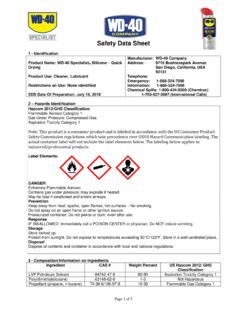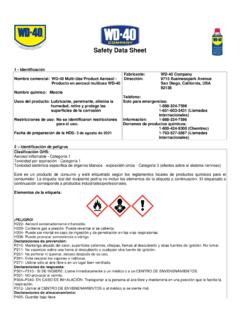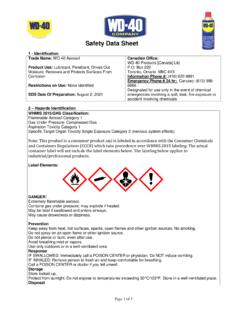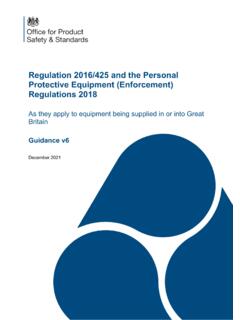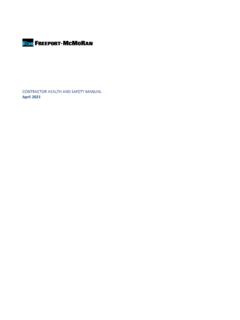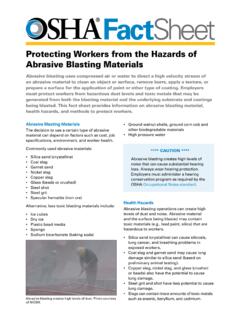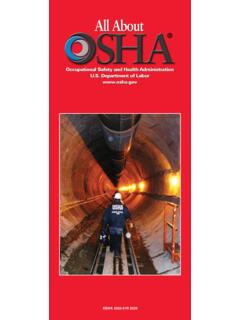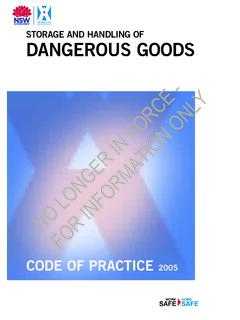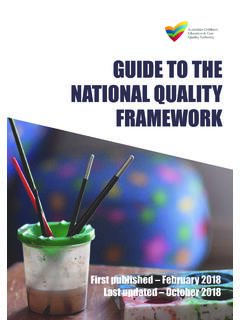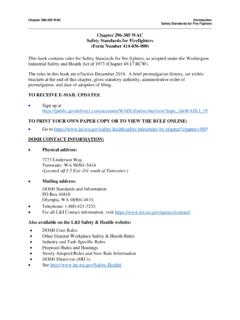Transcription of Material Safety Data Sheet (MSDS) - WD-40
1 Page 1 of 4 Safety Data Sheet 1 - Identification Product Name: 3-IN-ONE Telescoping Spout Multi-Purpose Oil Product Use: Lubricant Restrictions on Use: None identified SDS Date Of Preparation: July 18, 2018 Manufacturer: WD-40 Company Address: 9715 Businesspark Avenue San Diego, California, USA 92131 Telephone: Emergency: 1-888-324-7596 Information: 1-888-324-7596 Chemical Spills: 1-800-424-9300 (Chemtrec) 1-703-527-3887 (International Calls) 2 Hazards Identification Hazcom 2012/GHS Classification: Not hazardous Note: This product is a consumer product and is labeled in accordance with the US Consumer Product Safety Commission regulations which take precedence over OSHA Hazard Communication labeling.
2 Label Elements: None Required 3 - Composition/Information on Ingredients Ingredient CAS # Weight Percent US Hazcom 2012/ GHS Classification Severely Hydrotreated Heavy Naphthenic Oil 64742-52-5 >97 Not hazardous Naphtha, petroleum 64742-47-8 <2 Aspiration Toxicity Category 1 Non-Hazardous Ingredients Mixture <3 Not Hazardous Note: The exact percentages are a trade secret. 4 First Aid Measures Ingestion (Swallowed): While aspiration is unlikely due to viscosity, DO NOT induce vomiting. Call physician, poison control center or the WD-40 Safety Hotline at 1-888-324-7596 immediately. Eye Contact: Flush thoroughly with water.
3 Get medical attention if irritation persists. Skin Contact: Wash with soap and water. If irritation develops and persists, get medical attention. Inhalation (Breathing): If irritation is experienced, move to fresh air. Get medical attention if irritation or other symptoms develop and persist. Signs and Symptoms of Exposure: May cause mild eye irritation. Prolonged or repeated skin contact may cause mild irritation and defatting dermatitis. Indication of Immediate Medical Attention/Special Treatment Needed: Immediate medical attention is needed for ingestion. 5 Fire Fighting Measures Suitable (and unsuitable) Extinguishing Media: Use water fog, dry chemical, carbon dioxide or foam.
4 Do not use water jet or flooding amounts of water. Burning product will float on the surface and spread fire. Specific Hazards Arising from the Chemical: Slightly combustible liquid. If heated above the flashpoint, will release flammable vapors that can present a fire or explosion hazard. Special protective equipment and Precautions for Fire-Fighters: Firefighters should always wear positive pressure self-contained breathing apparatus and full protective clothing in areas where chemicals are used and stored. Cool fire-exposed containers with water. Page 2 of 4 6 Accidental Release Measures personal Precautions, protective equipment and Emergency Procedures: Wear appropriate protective clothing (see Section 8).
5 Eliminate all sources of ignition and ventilate area. Methods and Materials for Containment/Cleanup: Contain and collect liquid with an inert absorbent and place in a container for disposal. Clean spill area thoroughly. Report spills to authorities as required. 7 Handling and Storage Precautions for Safe Handling: Avoid contact with eyes. Avoid prolonged contact with skin. Avoid breathing oil mists. Use with adequate ventilation. Keep away from heat, hot surfaces and open flames. Wash thoroughly with soap and water after handling. Keep containers closed when not in use. Keep out of the reach of children.
6 Conditions for Safe Storage: Store in a cool, well-ventilated area, away from incompatible materials. NFPA Class IIIB Liquid. 8 Exposure Controls/ personal Protection Chemical Occupational Exposure Limits Severely Hydrotreated Heavy Naphthenic Oil 5 mg/m3 TWA ACGIH TLV (Inhalable) 5 mg/m3 TWA OSHA PEL Naphtha, petroleum 1200 mg/m3 TWA (manufacturer recommended) Non-Hazardous Ingredients None Established The Following Controls are Recommended for Normal Consumer Use of this Product Engineering Controls: Use in a well-ventilated area. personal Protection: Eye Protection: Avoid eye contact.
7 Skin Protection: Avoid prolonged skin contact. Wash hands with soap and water after use. Respiratory Protection: None needed for normal use with adequate ventilation. For Bulk Processing or Workplace Use the Following Controls are Recommended Engineering Controls: Use adequate general and local exhaust ventilation to maintain exposure levels below that occupational exposure limits. personal Protection: Eye Protection: Safety goggles recommended where eye contact is possible. Skin Protection: Wear chemical resistant gloves. Respiratory Protection: None required if ventilation is adequate.
8 If the occupational exposure limits are exceeded, wear a NIOSH approved respirator. Respirator selection and use should be based on contaminant type, form and concentration. Follow OSHA , ANSI and good Industrial Hygiene practice. Work/Hygiene Practices: Wash with soap and water after handling. 9 Physical and Chemical Properties Appearance: Clear amber liquid Flammable Limits: Not determined Odor: Faint citronella odor Vapor Pressure: Not Determined Odor Threshold: Not established Vapor Density: Not Determined pH: Not Applicable Relative Density: @ 20 C Melting/Freezing Point Not established Solubilities: Insoluble in water Boiling Point/Range: >550 F Partition Coefficient.
9 N-octanol/water: Not Determined Flash Point: Greater than 305 F Tag Open Cup Autoignition Temperature: Not Determined Evaporation Rate: Not Determined Decomposition Temperature: Not Determined Page 3 of 4 Flammability (solid, gas) Not applicable Viscosity: 112 SUS ( cSt) @ 100 F VOC: 0% Pour Point: Not Determined 10 Stability and Reactivity Reactivity: Not reactive under normal conditions Chemical Stability: Stable Possibility of Hazardous Reactions: May react with strong oxidizers generating heat. Conditions to Avoid: Avoid heat, flames and other sources of ignition. Incompatible Materials: Strong oxidizing agents.
10 Hazardous Decomposition Products: Carbon monoxide and carbon dioxide. 11 Toxicological Information Symptoms of Overexposure: Inhalation: High concentrations of oil mists may cause nasal and respiratory irritation. Skin Contact: Prolonged and/or repeated contact may produce mild irritation and defatting with possible dermatitis. Eye Contact: Contact may be irritating to eyes. May cause redness and tearing. Ingestion: This product has low oral toxicity. Swallowing may cause gastrointestinal irritation, nausea, vomiting and diarrhea. Chronic Effects: None expected. Carcinogen Status: None of the components are listed as a carcinogen or suspect carcinogen by IARC, NTP, ACGIH or OSHA.

